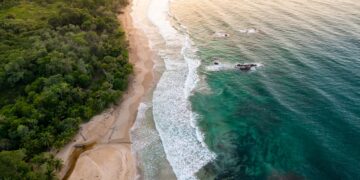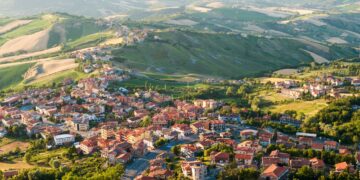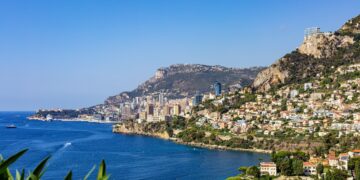When it comes to showcasing diverse landscapes and a rich cultural tapestry on the big screen, the Philippines has proven to be a veritable treasure trove. From its bustling urban centers to its idyllic islands, this Southeast Asian nation has been the backdrop for numerous movies, TV shows, and books that have captivated audiences worldwide.
Whether you’re a film enthusiast, a bookworm, or a travel junkie, this comprehensive guide will take you on a journey through the Philippines’ most famous filming locations. Discover where 10 famous films shot in Philippines were made, unravel the stories behind 5 TV shows set in Philippines, and explore the rich literary heritage embedded in the country’s landscape. So, buckle up and get ready for an unforgettable cinematic tour!
10 Famous Films Shot in The Philippines
The Philippines, with its exquisite natural beauty and distinctive urban landscapes, has served as the setting for a myriad of films. From heartwrenching dramas to action-packed blockbusters, here are 10 famous films shot in the Philippines:
- Apocalypse Now (1979) – Francis Ford Coppola’s epic war film, set during the Vietnam War, was actually filmed in various locations in the Philippines, including the provinces of Luzon and Baler.
- The Bourne Legacy (2012) – The fourth installment of the Bourne series takes its audience on a thrilling chase through the bustling streets of Manila, showcasing the city’s vibrancy and chaos.
- Brokedown Palace (1999) – While the story unfolds in Thailand, this gripping drama was predominantly shot in Manila, particularly in the infamous New Bilibid Prison.
- Heneral Luna (2015) – This critically-acclaimed biopic of a national hero brings to life the Philippines’ rich history, with scenes shot in Bulacan, Laguna, and Batangas.
- Metro Manila (2013) – This British-Filipino crime drama captures the stark contrasts of Manila, depicting the harsh realities of life in the city.
- Platoon (1986) – Oliver Stone’s war film, another portrayal of the Vietnam War, was shot in Luzon’s jungle landscapes.
- Survivor: Philippines (2012) – The 25th season of the popular reality series was filmed in the stunning Caramoan Islands, showcasing the country’s pristine beaches and lush foliage.
- The Year of Living Dangerously (1982) – While set in Indonesia, this political drama starring Mel Gibson was primarily shot in Manila.
- Amigo (2010) – This war drama set during the Philippine-American War was filmed in Bohol, featuring the province’s beautiful landscapes.
- On the Job (2013) – This gritty crime thriller dives deep into the underbelly of Manila, revealing the city’s darker side.
These films not only entertained global audiences but also highlighted the Philippines’ cinematic allure, inviting viewers to explore its unique charm through a multitude of stories.
5 TV Shows Set in The Philippines
The small screen has also found a home in the Philippines, with several TV shows capturing the essence of this dynamic country. Here are five series that have highlighted the country’s culture, history, and landscapes:
- Tadhana (2017-present) – This drama anthology series tells the real-life stories of Filipinos working abroad, offering a glimpse into the Filipino diaspora’s experiences.
- Survivor Philippines (2008-2012) – The Philippine version of the popular reality series was filmed in various stunning locations across the country, showcasing its natural beauty.
- Maalaala Mo Kaya (1991-present) – As the longest-running drama anthology in the country, this series has traversed the length and breadth of the Philippines to tell the stories of ordinary Filipinos.
- Be Careful With My Heart (2012-2014) – This popular romantic comedy series, set in Manila, showcases the city’s everyday life and the Filipino family’s warmth.
- Encantadia (2005-2006, 2016-2017) – Although a fantasy series, the show’s elaborate sets and costumes draw heavily from Philippine mythology and culture.
These TV shows have used the Philippines as more than just a setting—it’s a character that adds depth and authenticity to their narratives, enriching the stories with its unique charm.
5 Animated Films Set in The Philippines
The Philippines’ vibrant landscapes and rich culture have also inspired a host of animated adventures. Here are five animated films that have brought the spirit of the Philippines to the screen:
- Dayo: Sa Mundo ng Elementalia (2008) – This Filipino animated film takes viewers on a journey through a mythical world inspired by Philippine folklore.
- Urduja (2008) – This film tells the story of a legendary warrior princess from Pangasinan, showcasing the country’s rich history and traditions.
- RPG Metanoia (2010) – The first Filipino 3D animated film, it depicts a suburban Manila neighborhood, providing a glimpse into Filipino childhood and family life.
- Saving Sally (2016) – This live-action/animated film set in Manila presents the city from a whimsical, creative perspective.
- Hayop Ka! The Nimfa Dimaano Story (2020) – This adult animated film uses anthropomorphic animal characters to satirize the complexities and absurdities of modern Filipino life.
These animated features celebrate the Philippines’ unique blend of urbanity and mythology, providing audiences, especially children, with captivating stories and visuals that underscore the country’s allure.
Famous Books Set in The Philippines: Classic and Contemporary
The Philippines, known for its rich history, diverse culture, and picturesque landscapes, has been a vibrant setting for many literary works. Below are three classic and three contemporary books that bring the spirit of this archipelago to life:
Classic:
- “Noli Me Tangere” by Dr. Jose Rizal – This novel, considered a cornerstone of Philippine literature, paints a vivid picture of Filipino society during the Spanish colonial era.
- “America is in the Heart” by Carlos Bulosan – This semi-autobiographical novel provides a poignant depiction of the Filipino immigrant experience in the United States during the 20th century.
- “The Woman Who Had Two Navels” by Nick Joaquin – This novel delves into the psyche of the Filipino people during the American colonial period, exploring themes of identity and post-colonial trauma.
Contemporary:
- “Smaller and Smaller Circles” by F.H. Batacan – Set in Payatas, a poor district in Quezon City, this crime novel provides a grim but compelling exploration of modern Philippine society.
- “Illustrado” by Miguel Syjuco – This award-winning novel presents a multilayered narrative that spans generations, offering a satirical critique of the Filipino elite.
- “Dogeaters” by Jessica Hagedorn – This novel, set in Manila in the 1950s, captures the city’s vibrancy and chaos, painting a raw and complex image of post-colonial Philippines.
By telling stories that range from historical narratives to modern-day commentaries, these books offer readers a multifaceted glimpse into the Philippines, enhancing their understanding and appreciation of the country’s unique character.
Exploring Philippines Filming Locations – Where to Go
The Philippines, with its stunning landscapes, rich history, and vibrant cityscapes, has long been a favored canvas for filmmakers. If you’re eager to walk in the footsteps of movie stars and soak up the cinematic history of this diverse country, here are some essential filming locations you must visit:
- Banaue Rice Terraces – Known as the “Eighth Wonder of the World,” these terraces have been featured in various films, including “The Year of Living Dangerously” and “Thanos: Infinity War.”
- Manila – The capital city’s bustling streets, historic sites, and modern cityscape have been the backdrop for many movies, including “Metro Manila” and “The Bourne Legacy.”
- Pagsanjan Falls – This spectacular waterfall, located in Laguna, was one of the filming locations for “Apocalypse Now.”
- Taal Volcano – Featured in “Heneral Luna,” this active volcano and its surrounding lake provide a stunning backdrop for any film.
- Caramoan Islands – The pristine beaches and crystal-clear waters of this remote location were spotlighted in “Survivor: Philippines.”
Exploring the Philippines’ filming locations offers an exciting blend of entertainment and sightseeing, allowing visitors to engage with the country’s film heritage while enjoying its many cultural and natural attractions.
Where to Sleep in Philippines: 3 Cheap and 3 Luxury
Whether you’re after a lavish resort or a budget-friendly hostel, the Philippines offers a wide range of accommodations to suit all types of travelers. Here are three budget and three luxury options for your stay:
Budget:
- Pink Manila Hostel – A vibrant hostel in Manila, offering budget-friendly dormitory-style accommodation with a rooftop pool.
- Our Melting Pot Hostel – Located in El Nido, Palawan, this hostel offers affordable private and shared rooms, perfect for backpackers.
- Frendz Resort Boracay – This popular hostel in Boracay provides budget accommodation with a social atmosphere, just a few steps from the island’s famous white-sand beach.
Luxury:
- Shangri-La’s Boracay Resort and Spa – This 5-star resort offers luxurious accommodations with breathtaking views of the sea, coupled with world-class amenities and services.
- El Nido Resorts – With several locations in Palawan, these eco-resorts provide luxurious accommodations amidst stunning natural surroundings.
- The Manila Hotel – This historic 5-star hotel in Manila offers opulent accommodations and top-notch services, allowing guests to experience the grandeur of the Philippines’ past.
From budget hostels to luxurious resorts, the Philippines offers a range of accommodations that cater to every traveler’s needs, ensuring a comfortable and memorable stay.
Where to Eat in Philippines: From Flavorful Bargains to Opulent Tables
In the Philippines, dining is an adventure in itself. From budget-friendly street food to high-end restaurants, the country offers a myriad of gastronomic experiences that cater to all budgets. Here are three budget-friendly and three luxury options to consider:
Budget:
- Mang Inasal – This popular chain serves the Filipino favorite “Inasal” (barbecued chicken) at very affordable prices.
- Jollibee – Dubbed as the Philippines’ answer to McDonald’s, Jollibee is loved for its unique take on Western fast-food staples.
- Street Food Stalls – Across the country, particularly in Manila, you’ll find vendors selling budget-friendly street food, including “balut” (duck embryo), “isaw” (grilled chicken intestines), and “kwek-kwek” (fried quail eggs).
Luxury:
- Antonio’s – Located in Tagaytay, this fine dining restaurant is considered one of the best in the Philippines, known for its exquisite menu and elegant setting.
- Gallery by Chele – In Bonifacio Global City, this restaurant offers a modern gastronomic experience featuring local ingredients through its innovative tasting menu.
- Spiral – Located in Sofitel Philippine Plaza Manila, Spiral is renowned for its luxurious buffet, featuring 21 dining ateliers that serve a variety of international cuisines.
Whether you’re in the mood for a quick snack or a lavish feast, the Philippines’ culinary scene is sure to satisfy your cravings.
Best Itinerary for Exploring Philippines Filming Locations Day by Day
Embark on a 5-day cinematic journey across the Philippines, visiting iconic filming locations from 10 famous films shot in the Philippines. Here’s a detailed day-by-day itinerary:
Day 1: Manila
Begin your tour in Manila, the nation’s capital. Visit historic sites such as Rizal Park and Intramuros, both of which have been used in numerous local and international productions. Explore the bustling streets of Makati and Bonifacio Global City, featured in “The Bourne Legacy” and “Metro Manila”.
Day 2: Taal and Tagaytay
Head south to Taal, Batangas, where you can visit the heritage town featured in “Heneral Luna”. Then, proceed to Tagaytay to enjoy the breathtaking view of Taal Volcano, another filming location.
Day 3: Pagsanjan
Travel to Pagsanjan, Laguna, and experience a thrilling boat ride to Pagsanjan Falls, featured in “Apocalypse Now”. You can also visit the centuries-old Pagsanjan Arch, another popular filming location.
Day 4: Banaue
Fly north to Ifugao and marvel at the majestic Banaue Rice Terraces, used in “Thanos: Infinity War”. While there, learn about the rich culture of the Ifugao people.
Day 5: Boracay
Fly south to Boracay, one of the filming locations for “Survivor: Philippines”. Enjoy the island’s pristine beaches and vibrant nightlife.
This itinerary offers a balance of city exploration, historical sightseeing, and beach relaxation, allowing you to experience the Philippines’ diverse landscapes and rich cinematic history.
Local Cryptid Legends and Curiosities About the Philippines Film Industry
The Philippines has a rich folklore filled with tales of mythical creatures, or cryptids, that continue to inspire films and TV shows. Stories of “aswangs” (shapeshifting monsters), “kapres” (giant tree trolls), and “diwatas” (nature spirits) lend a unique flavor to the country’s cinematic narratives.
Moreover, the Philippine film industry, one of the oldest in Asia, is known for its resilience. Despite the numerous challenges it has faced, including a strict censorship regime during the Marcos dictatorship and the rise of foreign films, it continues to produce globally-recognized films.
Also notable is the rise of independent cinema in the Philippines. Independent films, or “indie films”, have been gaining international acclaim, highlighting the country’s social issues and showcasing its cultural diversity.
These cryptid legends and industry curiosities add a layer of intrigue to the Philippine cinematic landscape, offering a deeper understanding of the country’s unique film culture.
Hidden Gems in The Philippines
Beyond the popular tourist spots and famous filming locations, the Philippines is full of hidden gems waiting to be discovered. These lesser-known destinations offer a glimpse into the country’s off-the-beaten-path beauty:
- Batanes – This northernmost province, with its rolling hills and rugged cliffs, offers a tranquil escape from the city’s hustle and bustle.
- Guimaras – Known for producing the sweetest mangoes, this small island also boasts pristine beaches and a serene rural landscape.
- Siquijor – Often associated with witchcraft and mysticism in local folklore, this island is actually a peaceful haven with stunning waterfalls, ancient balete trees, and white sand beaches.
- Camiguin – Dubbed as the “Island Born of Fire”, this island province is home to several volcanoes, hot springs, and a sunken cemetery.
- Danjugan Island – This marine reserve and wildlife sanctuary in Negros Occidental is a paradise for nature lovers and conservation advocates.
Whether it’s the serene beauty of Batanes or the enchanting allure of Siquijor, these hidden gems offer unique travel experiences that go beyond typical tourist trails.
What to Pack for a Trip to The Philippines
When planning a trip to the Philippines, it’s important to pack accordingly to ensure a comfortable and hassle-free travel experience. Here’s what to include in your luggage:
- Light Clothing – The Philippines has a tropical climate, so lightweight and breathable clothes are a must. Don’t forget your swimwear for beach trips!
- Rain Gear – The country experiences a rainy season from June to November, so a raincoat or umbrella could come in handy.
- Sun Protection – Sunscreen, sunglasses, and hats are essential to protect yourself from the sun, especially when exploring outdoor filming locations.
- Comfortable Footwear – Whether you’re navigating through the busy streets of Manila or trekking up the Banaue Rice Terraces, comfortable shoes are a must.
- Insect Repellent – This is especially useful when visiting rural areas or beaches.
- Universal Adapter – The Philippines uses Type A, B, and C outlets, so a universal adapter will ensure that you can charge your gadgets.
- Personal Medication – If you’re on any medication, make sure to bring enough for the duration of your trip.
Remember, it’s always best to pack light and only bring what you need. This leaves room for any souvenirs you might want to bring home!
Transportation Tips for Getting Around the Philippines Filming Locations
Navigating through the Philippines’ diverse landscapes and cityscapes can be an exciting adventure. Here are some transportation tips to help you explore the country’s famous filming locations:
- Jeepneys and Tricycles – These are the most common modes of public transportation in the Philippines. They’re an affordable way to get around city centers and nearby locations.
- Taxis and Ride-Sharing Services – For convenience and comfort, taxis and ride-sharing services like Grab are widely available in major cities.
- Buses and Vans – These are ideal for long-distance travel between provinces or regions.
- Ferries and Boats – With over 7,000 islands, ferry services and boat rentals are essential for island-hopping adventures.
- Flights – The Philippines has several domestic airports, making flights a convenient option for traveling long distances across the archipelago.
- Car Rental – Renting a car or hiring a driver is also an option, especially if you want more control over your schedule.
Remember, Philippine traffic can be unpredictable, so always allot extra travel time to ensure that you don’t miss any of your planned activities.
Travel Documents Needed for Visiting the Philippines
When planning a trip to the Philippines, a country known for its beautiful islands, rich history, and vibrant culture, it’s crucial to have the necessary travel documents. These include:
- Passport – Your passport should be valid for at least six months beyond the date of your departure from the Philippines.
- Visa – Depending on your nationality, you may need a visa to enter the Philippines. Check with the Philippine Embassy or Consulate in your home country for specific requirements.
- Return Ticket – You may be asked to present a return or onward ticket upon your arrival in the Philippines.
- Accommodation Confirmation – Proof of accommodation, such as hotel booking confirmation, may also be required.
- Proof of Sufficient Funds – You may need to show proof of enough money to cover your expenses during your stay in the Philippines.
Remember, requirements may vary depending on your nationality and purpose of visit, so it’s best to check with the appropriate authorities before your trip.
Conclusion: Your Ultimate Philippines Movie Tour Guide
With its stunning landscapes, vibrant cities, and rich culture, the Philippines offers a unique cinematic journey that’s sure to captivate any film enthusiast. From exploring the bustling streets of Manila as seen in “Metro Manila” to walking along the pristine beaches of Caramoan Islands featured in “Survivor: Philippines”, there’s so much to see and experience in this Southeast Asian gem. So pack your bags, brush up on your Filipino film knowledge, and get ready for your ultimate Philippines movie tour!













